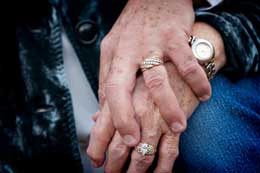18 July 2013
 The advance of years is often associated with the advance of aches and pains, but for those attending The University of South Australia’s Successful Ageing Seminar next week, Professor Lorimer Moseley and Dr Tasha Stanton will outline how ageing can be less painful than imagined.
The advance of years is often associated with the advance of aches and pains, but for those attending The University of South Australia’s Successful Ageing Seminar next week, Professor Lorimer Moseley and Dr Tasha Stanton will outline how ageing can be less painful than imagined.
Prof Moseley, leader of the Sansom Institute for Health Research and the Body in Mind research group is an expert in the area of pain and in developing non-pharmacological treatments to help those who suffer from chronic pain disorder – a condition estimated to cost Australia $35 billion a year.
At the seminar Prof Moseley will explain why pain really is all in the head, but not in the way some people think, and will also detail what pain actually is.
Prof Moseley’s work has shown that the burden of pain can be reduced simply by understanding it and that there effective ways to help people understand it.
“One of the things that make humans so successful as a species is our ability to evaluate and use all sorts of cues to make ‘shortcuts’,” Prof Moseley says.
“Usually, these shortcuts help us, but sometimes, for example in chronic pain, they actually hinder us and do that by making our pain worse. Understanding and identifying some of the shortcuts that our brain is making can reduce our pain and, importantly, reduce its impact on our life.”
Postdoctoral research fellow Dr Stanton, who will deliver a presentation on the brain and osteoarthritis at the seminar, says our experience of pain may relate to how we perceive parts of our body.
“People who have osteoarthritis, which includes half of those aged over 65, can have altered perceptions of their body,” she says.
“Research has shown that people with hand osteoarthritis who are asked to identify their own hand size (from images of their real hand that are made to look shorter and longer) will pick an image of a hand which is smaller than the size of hand that people without pain will choose. This seems unusual but is actually indicative of that altered sense of body perception.
"What is most interesting is that this altered perception may relate to pain. When we alter the visual appearance of the hand (i.e. - make it look stretched or shrunken) using visual illusions, pain decreases or sometimes disappears entirely in people with hand osteoarthritis.
“We know that our brain holds maps of our body and one of the theories behind altered perception is that these brain maps have changed. It is thought that these brain changes may contribute to the pain that is experienced in osteoarthritis. Perhaps the visual illusions work to temporarily ‘re-set’ these altered body maps in the brain.
“Our brains play a key role in how we experience pain and there are some exciting strategies which aim to target the brain that may assist us in relieving pain.”
Registrations to attend the Successful Ageing Seminar are now closed but a video recording of the seminar is expected to be made available through the UniSA website in mid-August.
Media contact: Will Venn office 8302 0965 email Will.Venn@unisa.edu.au



